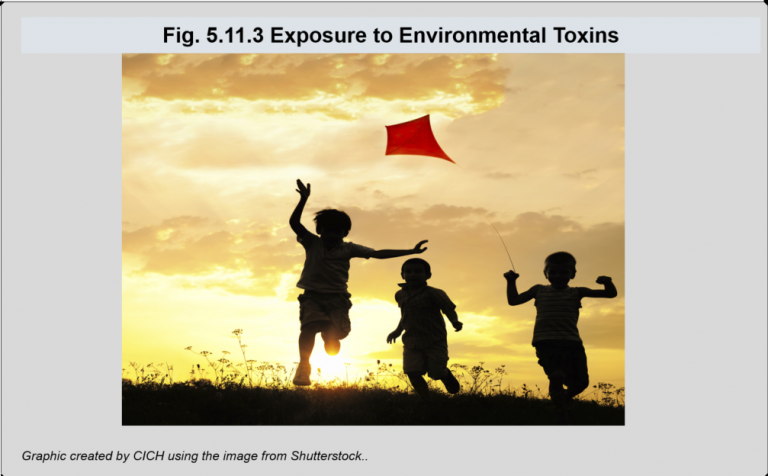Exposure to Environmental Toxins

Children have heightened vulnerability to a variety of exposures as a consequence of their developmental, behavioural and physiological characteristics.
They receive greater exposures per unit of body weight than adults because – for their size – they eat more food, drink more liquids and breathe more air than adults. Because of young children’s physical development, their bodies are less able to manage environmental toxins.
Exposures at this critical period of development can result in irreversible damage to the growing nervous system, affect emerging behaviour patterns, cause immune dysfunction and have serious reproductive effects.
Young children’s behaviour often places them at higher risk than adults to certain environmental hazards, including their exploratory behaviour, frequent hand-to-mouth activity and proximity to the ground – all of which result in greater contact with sources of contamination.1
1Canadian Institute of Child Health. 2000. The Health of Canada’s Children: A CICH Profile. p.252.
Implications
Indigenous children are at greater risk of exposure to environmental hazards, increasing their susceptibility to a number of physical illnesses and mental health issues.2 They are more likely to live in homes needing major repairs or in crowded homes, increasing their susceptibility to respiratory illnesses, the spread of infectious diseases like flu and tuberculosis, injuries and stress. Indigenous infants are also more likely to be exposed to tobacco smoke in utero, which increases the risk of perinatal mortality, preterm birth, low birth weight, congenital abnormalities, sudden infant death syndrome (SIDS), behavioural problems and reduced academic achievement.3 In addition, they are also more likely to be exposed to secondary smoke, increasing their susceptibility to otitis media, respiratory illnesses, SIDS, cancer, childhood invasive meningococcal disease, neurocognitive deficits and behavioural problems. A heavy reliance on traditional food diets, which can be contaminated with heavy metals, pesticides, and other chemicals, can increase the risk of damage to Indigenous children’s developing brains, leading to behavioural problems, intellectual deficits, learning disabilities, and vision or hearing problems.4 Indigenous people are also more likely to live in communities with contaminated water and drinking water advisories in place due to poor water and sanitation systems, and often live in areas of natural resource extraction or industrial projects, leaving them vulnerable to environmental contamination from industrial waste and pollution.5 A better understanding of the health implications of exposure to environmental hazards is therefore necessary for improving Indigenous children’s health.
2Assembly of First Nations. (n.d.). Children and environmental health. Ottawa, ON: Author. Retrieved October 12, 2017 from http://www.afn.ca/uploads/files/env/ns_-_children_and_environmental_health.pdf
3Radha, J., Canadian Paediatric Society, First Nations, Inuit and Métis Health Committee. (2017). Tobacco use and misuse among Indigenous children and youth in Canada: Position Statement. Canadian Paediatric Society, July.
4Union of Ontario Indians. Anishinabek Health Secretariat. (2009). First Nation Children’s Environmental Health. Toronto, ON: Author.
5Phare, M.-A.S. (2009). Denying the source: The crisis of First Nations water rights. Surrey, BC: Rocky Mountain Books; Sandlos, J., & Keeling, A. (2016). Aboriginal communities, traditional knowledge, and the environmental legacies of extractive development in Canada. The Extractive Industries and Society, 3(2), 278-787.
